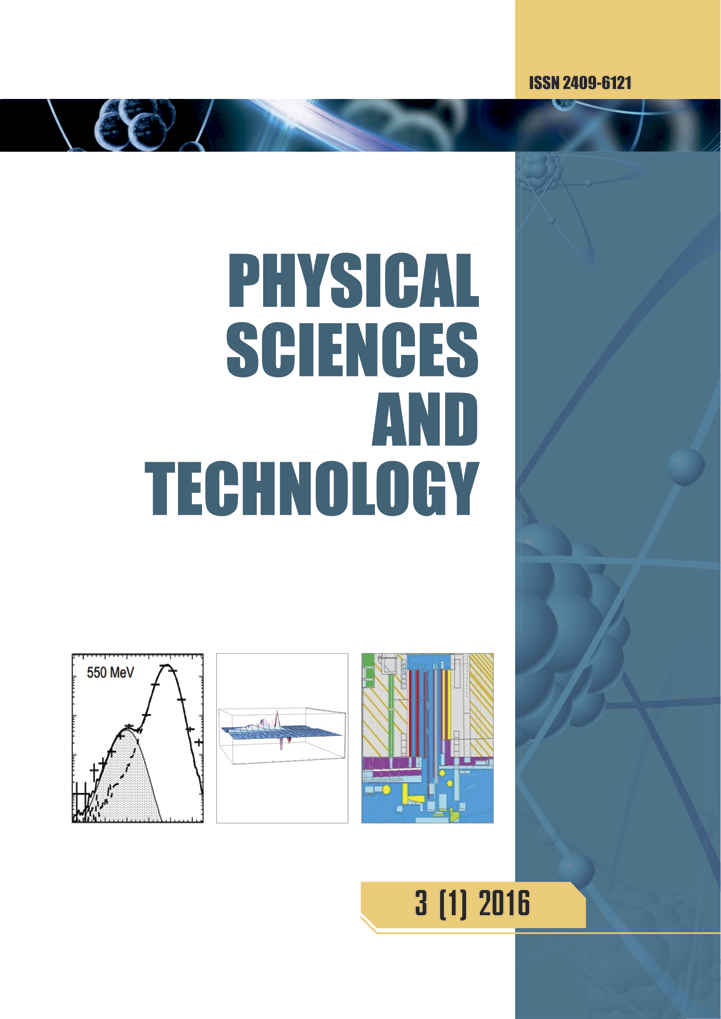Model of 9Be nucleus as "quasi-molecular" state of “n+a+a” system
DOI:
https://doi.org/10.26577/phst-2014-1-22Keywords:
beryllium 9, nuclear models, quasi-molecular state, Born-Oppenheimer approximation, three body problem.Abstract
The 9Be nuclide has been considered as a system of two alpha-particles and one neutron and it has been shown that such system can exist in "quasi-molecular" state, when the wave number of a pair of heavy particles becomes imaginary with the wave number of the light particle being a real quantity. That is, rescattering of light particles on the two heavy particles creates additional attraction between the heavy particles and "binds" this heavy pair. The total energy of the system becomes negative: , m is the mass of the light particle, and M is the mass of the heavy particle. Since , the total energy of the system has a minimum for the variable . The estimates were obtained in the Born-Oppenheimer approximation, where the choice of the pair potentials in separable form allows to solve the three body problem in a simple and compact form.References
[1] Horiuchi H., Ikeda K., Kato K. Recent Developments in Nuclear Cluster Physics // Progress of Theoretical Physics Supplement. – 2012. – Vol. 192. – P. 1-19.
[2] Tomberlin T.A. Beryllium – A Unique Material In Nuclear Applications // 36th International SAMPE Technical Conference: INEEL/CON-04-01869 PREPRINT, 2004. – P. 1-12.
[3] Chakin V., Moeslang A. et al. Beryllium Application for Fission and Fusion // International Symposium on Materials Testing Reactors: Book of proceedings. – JAEA Oarai R@D Center, Japan, 2008. – P. 107-116.
[4] Levin V.E. Nuclear Physics and Nuclear Reactors. – M.: Atomizdat, 1979. – 376 p.
[5] Day J.P, McEwen J.E. et al. The α-α-fishbone potential revisited // USA: California State University, 2011. – arXiv: 1105.6050v1 [nucl.-ph.]. – 4 p.
[6] Faddeev L.D. Mathematical Aspects of the Three Body Problem in Quantum Scattering Theory // Israel, Jerusalem: Program for Scientific Translations, 1965.– P. 114.
[7] Ajzenberg-Selone F. Energy levels of light nuclei // Nuclear Physics A. – 1988. – Vol. 490. – P. 1-169.
[8] Takibayev N. Zh. Class of Model Problems in Three-Body Quantum Mechanics That Admit Exact Solutions // Physics of Atomic Nuclei. – 2008. – Vol. 71. – No. 3. – P. 460–468.
[9] Takibayev N.Zh. Exact Analytical Solutions in Three-Body Problems and Model of Neutrino Generator // EPJ Web of Conferences. – 2010. – Vol. 3. – P. 05028.
[10] Takibayev N. Zh. Neutron Resonances in Systems of Few Nuclei and Their Possible Role in Radiation of Overdense Stars // Few-Body Systems. – 2011. – Vol. 50. – P. 311–314.
[11] Mughabghab S.F., Divadeenam M., Holden N.E. Neutron Cross Sections. – NY: Academic Press, 1981. – Vol. 1. – Part A. – P. 1-408.
[2] Tomberlin T.A. Beryllium – A Unique Material In Nuclear Applications // 36th International SAMPE Technical Conference: INEEL/CON-04-01869 PREPRINT, 2004. – P. 1-12.
[3] Chakin V., Moeslang A. et al. Beryllium Application for Fission and Fusion // International Symposium on Materials Testing Reactors: Book of proceedings. – JAEA Oarai R@D Center, Japan, 2008. – P. 107-116.
[4] Levin V.E. Nuclear Physics and Nuclear Reactors. – M.: Atomizdat, 1979. – 376 p.
[5] Day J.P, McEwen J.E. et al. The α-α-fishbone potential revisited // USA: California State University, 2011. – arXiv: 1105.6050v1 [nucl.-ph.]. – 4 p.
[6] Faddeev L.D. Mathematical Aspects of the Three Body Problem in Quantum Scattering Theory // Israel, Jerusalem: Program for Scientific Translations, 1965.– P. 114.
[7] Ajzenberg-Selone F. Energy levels of light nuclei // Nuclear Physics A. – 1988. – Vol. 490. – P. 1-169.
[8] Takibayev N. Zh. Class of Model Problems in Three-Body Quantum Mechanics That Admit Exact Solutions // Physics of Atomic Nuclei. – 2008. – Vol. 71. – No. 3. – P. 460–468.
[9] Takibayev N.Zh. Exact Analytical Solutions in Three-Body Problems and Model of Neutrino Generator // EPJ Web of Conferences. – 2010. – Vol. 3. – P. 05028.
[10] Takibayev N. Zh. Neutron Resonances in Systems of Few Nuclei and Their Possible Role in Radiation of Overdense Stars // Few-Body Systems. – 2011. – Vol. 50. – P. 311–314.
[11] Mughabghab S.F., Divadeenam M., Holden N.E. Neutron Cross Sections. – NY: Academic Press, 1981. – Vol. 1. – Part A. – P. 1-408.
Downloads
How to Cite
Takibayev, N. (2015). Model of 9Be nucleus as "quasi-molecular" state of “n+a+a” system. Physical Sciences and Technology, 1(1). https://doi.org/10.26577/phst-2014-1-22
Issue
Section
Nuclear Physics and Related Techology




